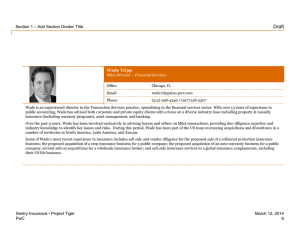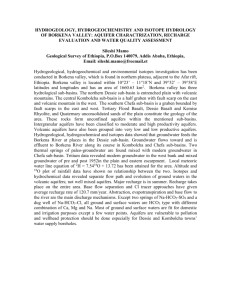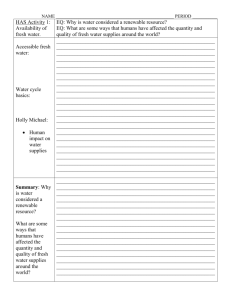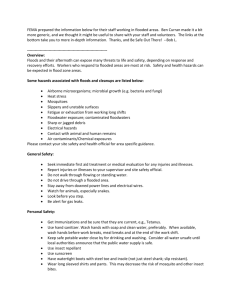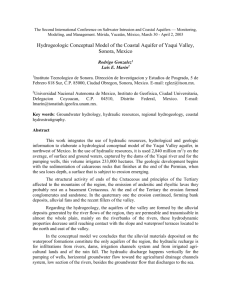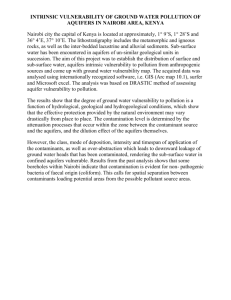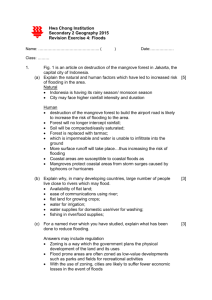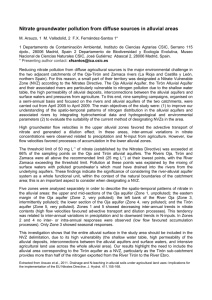WADE - CORDIS
advertisement
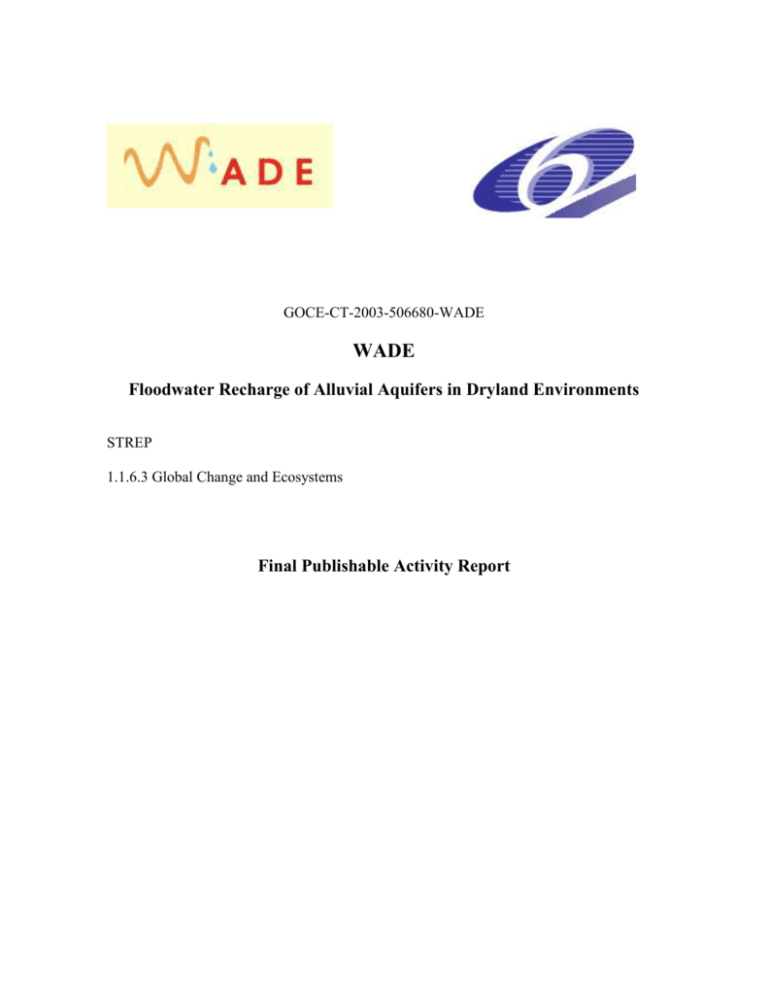
GOCE-CT-2003-506680-WADE WADE Floodwater Recharge of Alluvial Aquifers in Dryland Environments STREP 1.1.6.3 Global Change and Ecosystems Final Publishable Activity Report EXECUTIVE SUMMARY The WADE approach The overall scope of WADE is to apply newly developed methodologies and technologies in order to assess long-term (decades to centuries) water resources in selected semiarid to hyperarid ephemeral river basins by determining long-term magnitude and frequency of floods and quantifying transmission losses and floodwater recharge into alluvial aquifers. Research experience on integrated water resource management in basins of Spain and Israel are twinned with research initiatives in the Kuiseb (Namibia) and the Buffels (Namaqualand, South Africa) river basins, both of which suffer from aridity and water scarcity. WADE objectives The key objective of this project is to develop and apply an innovative method of investigating the occurrence of floodwater resources, in time and space, to quantify the sustainable water yield of selected ephemeral streams and to formulate integrated water management strategies for their use. The following principal objectives will be met during the project’s 3 year duration: To extend the record of the magnitude and chronology of large floods using palaeoflood hydrology in order to obtain improved understanding of the magnitude and frequency of floods. This will allow for better long-term water management strategies in these basins, planners can base their decisions on long-term (decades and longer) flooding potential, providing a sustainable approach to a varying water resource on the annual-decadal time scale. The chronology of large floods will also indicate their sensitivity to climatic variability. To directly quantify the processes of floodwater infiltration, transmission losses and percolation through the channel bed into shallow aquifers. To establish isotope-based indicator methods to identify active recharge sections and, therefore, potential development areas along alluvial aquifers. To formulate and quantify a model of groundwater recharge from floodwaters along long reaches of ephemeral rivers in dryland environments. The model that will be conceptualised and formulated can later be used as a basis for research, planning, and development programs in other arid lands around the world. To increase local and national awareness and understanding of the water resource potential of alluvial aquifers in dryland areas, both quantitatively and qualitatively. This will lead to better, scientifically-based, water resource development/management in arid lands, allowing optimal exploitation and conservation of both water resources and economic means. 2 To enhance cooperation and collaboration among scientists, engineers, risk analysts, policy makers, government/management agencies, local communities and the inhabitants along a river. Enhancing and improving a sustainable watershed management that supports both water resource management as well as restoration of the watershed ecologic system in arid lands. WADE project workpackages WP1 WADE project management The main objectives are the efficient and effective management of the project, including coordination between all the partners of the project consortium and liaison with the EC. WP2 Site characterisation Site characterisation has three principal goals: 1) to determine the general characteristics and dynamics of the selected ephemeral channels; 2) to choose the optimum sites for probe installation and sample collection and 3) identify the role of alluvial aquifers in the socioeconomy of the catchments. Site characterisation integrates information from geomorphic, flood and palaeoflood hydrology, soil and sediment information, knowledge on the local groundwater and its use as a water resource. The WP is complementary to WP’s 3-6 and pulls together the differing research themes developed in the other WP’s. WP3 Reconstructing long-term flood magnitude and frequency The reconstruction of long-term flood chronologies, over centuries to millennia, using palaeoflood and historical data to obtain a long-term frequency of floodwater recharge events. WP4 Monitoring of surface and subsurface water To monitor transmission losses through the river bed during flood events in order to estimate rates of groundwater recharge. In order to achieve this the status and behaviour of the surface and subsurface hydrological system will be monitored during floods. WP5 Demonstration of TDR and installation The monitoring of subsurface water within WP4 requires significant, state of the art technological input, with the drilling and installation of monitoring equipment, including the TDR probes. This WP aims to demonstrate the successful installation and running of the technology, including its ability to accurately monitor sub-surface water flow. WP6 Modelling of transmission losses To model, using several independent approaches, temporal changes in the vadose zone moisture profiles associated with surface flood and palaeoflood stages determined along the rivers (using data collected from WP’s 3 and 4). WP7 Participatory water management: socio-economic & historical perspectives To evaluate the socio-economic importance of water resources from shallow alluvial aquifers, for the population of the study basins. To understand environmental changes within catchment 3 areas in terms of water management, land use, policy, climate change and other determining factors. The impact of current policy options and institutional structures on the sustainability of alluvial aquifer management practices will be determined. Finally strategies for an integrated water management approach, using floodwater as a water resource, will be formulated using the data generated in WP’s 2-6. WP8 Results’ dissemination The main objectives of this WP are to identify optimal dissemination pathways to ensure that the project data, deliverables and resource management tools are distributed to their maximum potential to end-users and the scientific community. List of Contractors Partner Participant name Short name Country 1 Consejo Superior de Investigaciones Cientificas CSIC ES 2 Hebrew University of Jerusalem HUJI IL 3 HYDROISOTP gmbh HY D 4 Desert Research Foundation of Namibia DRFN NA 5 University of Edinburgh UEDIN UK 6 University of Cape Town UCT SA 7 Institut National de la Recherche Scientifique INRS CA 8 Ben Gurion University BGU IL 9 Ministry of Agriculture, Water & Rural Development, Namibia MAWRD NA 10 Surplus People Project SPP SA 11 Kamiesberg Municipality KM SA 12 Nama Khoi Municipality NKM SA WADE web page: www.wadeproject.info WADE coordinator Gerardo Benito, Consejo Superior de Investigaciones Cientificas Centro de Ciencias Medioambientales, Serrano, 115 bis, 28006 Madrid, Spain benito@ccma.csic.es 4
